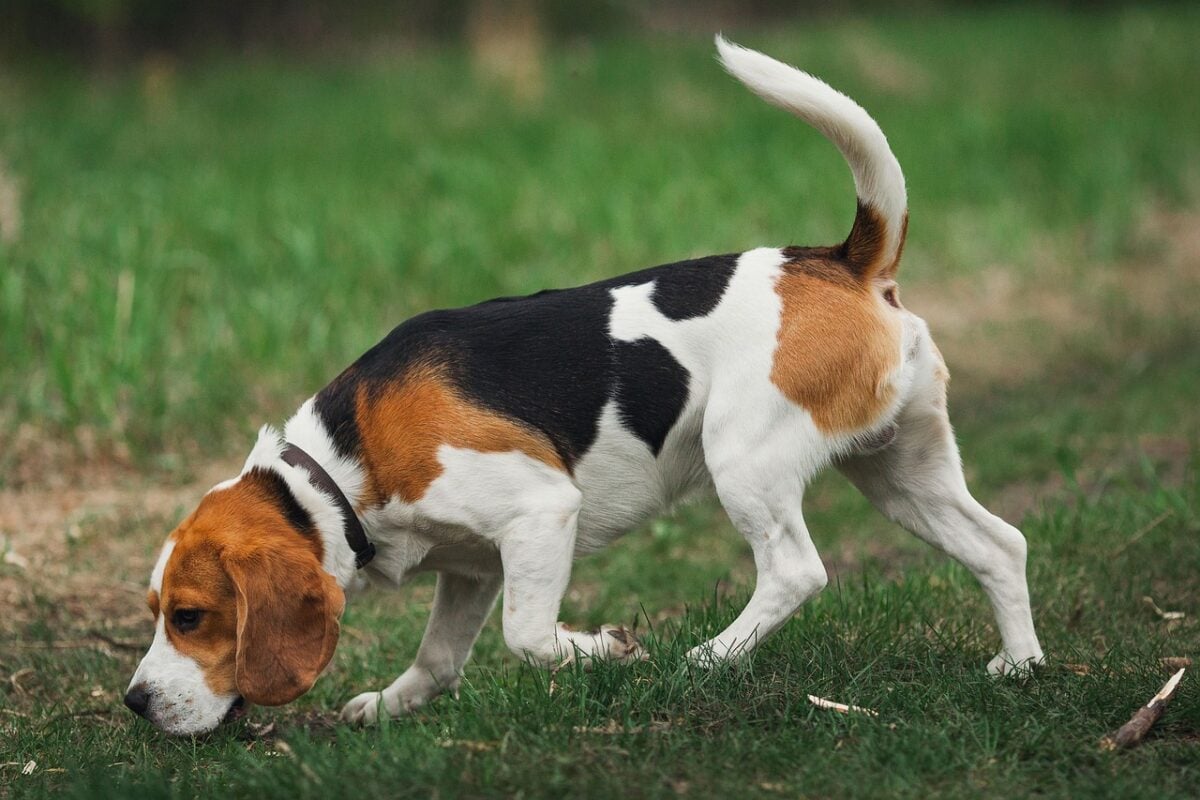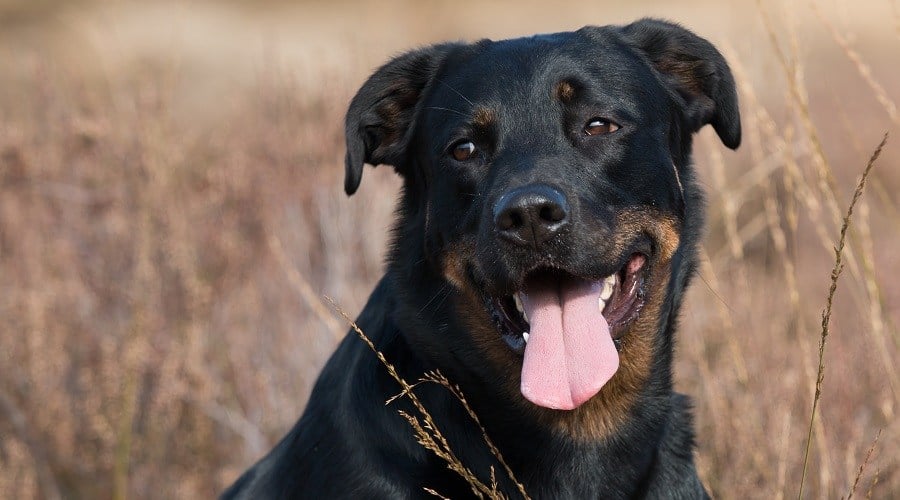Part Beagle, Part Dachshund, All Attitude: The Doxle Explained
When you purchase through links on our site, we may earn a commission. Here’s how it works.
Meet the Doxle, the Beagle Dachshund mix known for its clever and mischievous personality.
Table of Contents
This mix — also called the Beaschund — blends the Beagle’s curiosity with the Dachshund’s fearless nature to create a small dog bursting with energy and charm.
You’ll find them sniffing every scent in the yard one minute and digging into your couch cushions the next. They are loyal, funny, and full of heart but can be strong-willed when it comes to training.
If you want an affectionate dog with a lively spirit and plenty of character, the Doxle could be your perfect match.
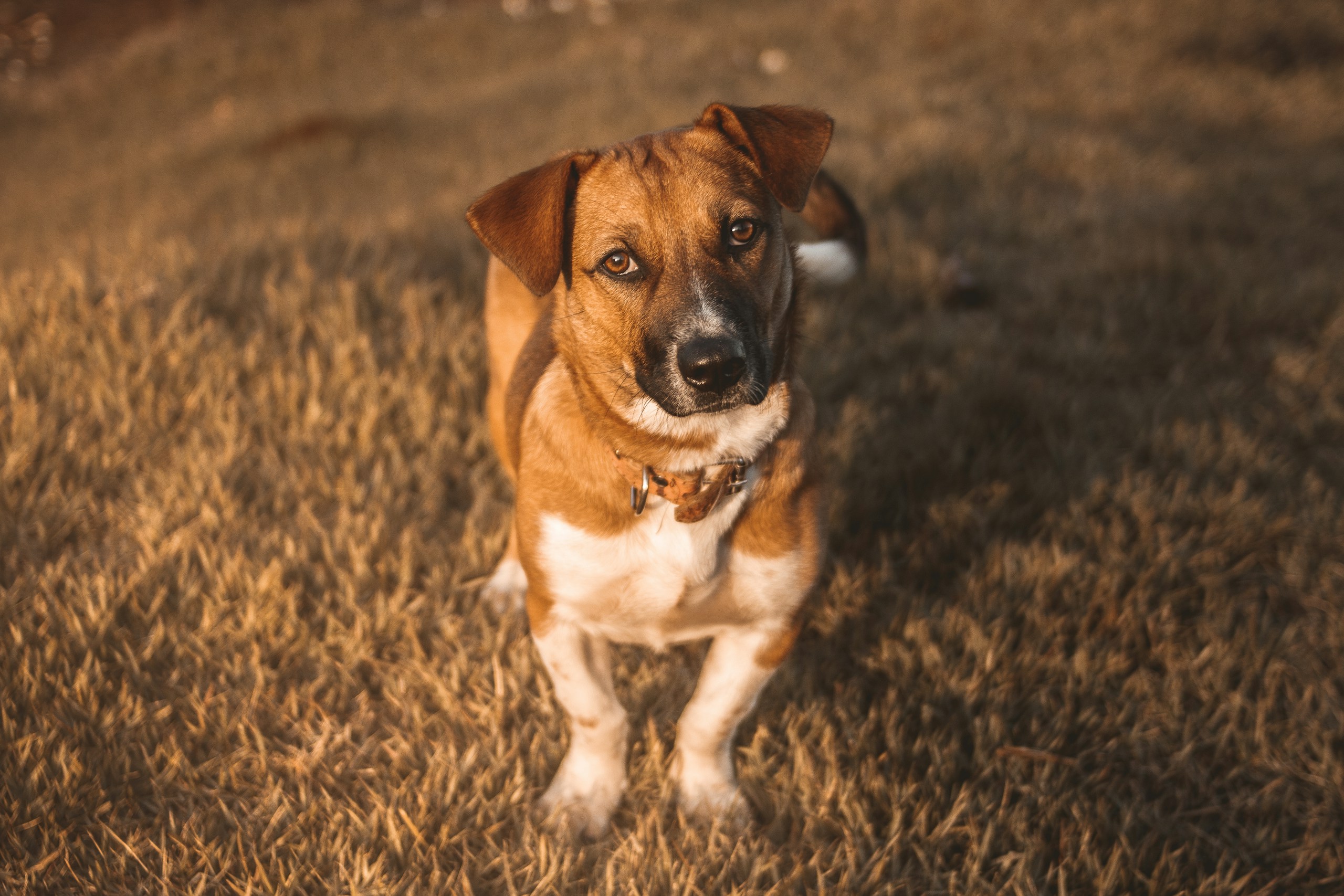
Doxle Parent Breeds
When you mix the Beagle’s curiosity with the Dachshund’s fearless spirit, you get a small dog with a big personality. The Doxle inherits a blend of charm, courage, and stubborn streaks from both sides.
Each pup looks a little different. Some favor the long body and short legs of the Dachshund, while others have the soft face and floppy ears of a Beagle.
Both parent breeds are hounds with powerful scenting instincts. The Beagle loves to follow its nose, while the Dachshund is driven to dig for what it finds.
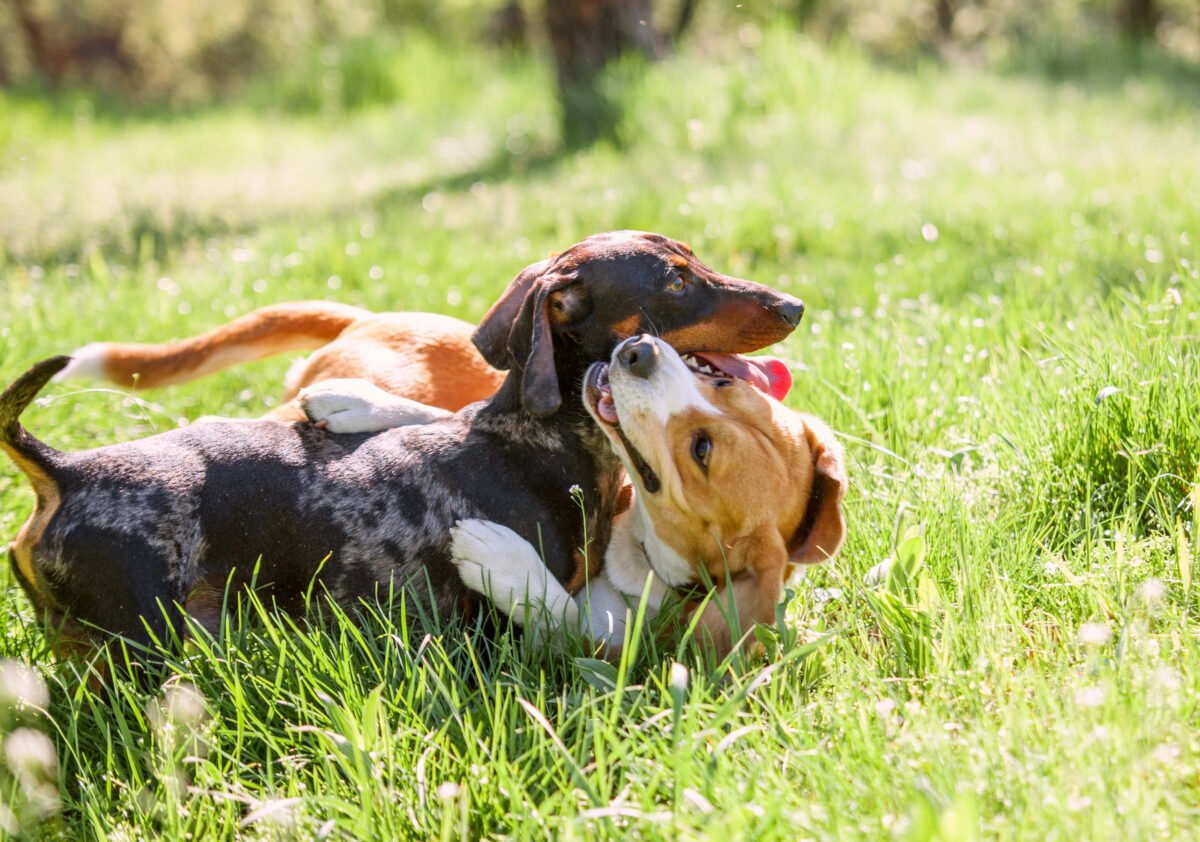
Beagle Overview: The Curious Companion
The Beagle began as a hunting dog in 16th-century England. It was bred to track rabbits and other small game with precision and enthusiasm.
Modern Beagles are just as spirited and affectionate as their ancestors. They are social, loyal, and famously stubborn when they catch a scent.
Beagles love being around people (including children) and other dogs. They thrive in active homes where they can use their nose and get plenty of attention.
Key Traits
- Appearance: Compact, muscular body with floppy ears and expressive brown eyes
- Temperament: Friendly, vocal, playful, and sometimes headstrong
- Other Traits: Needs regular exercise, can be food-motivated, and has a strong prey drive
Dachshund Overview: The Fearless Digger
The Dachshund originated in Germany and was bred to hunt badgers. Its long, low body and brave personality made it perfect for underground work.
They arrived in the U.S. in the late 1800s and quickly became beloved family pets. Their confidence and charm earned them the nickname “wiener dog.”
Dachshunds are affectionate but can also be protective of their families. They love attention, enjoy playtime, and do best with early socialization.
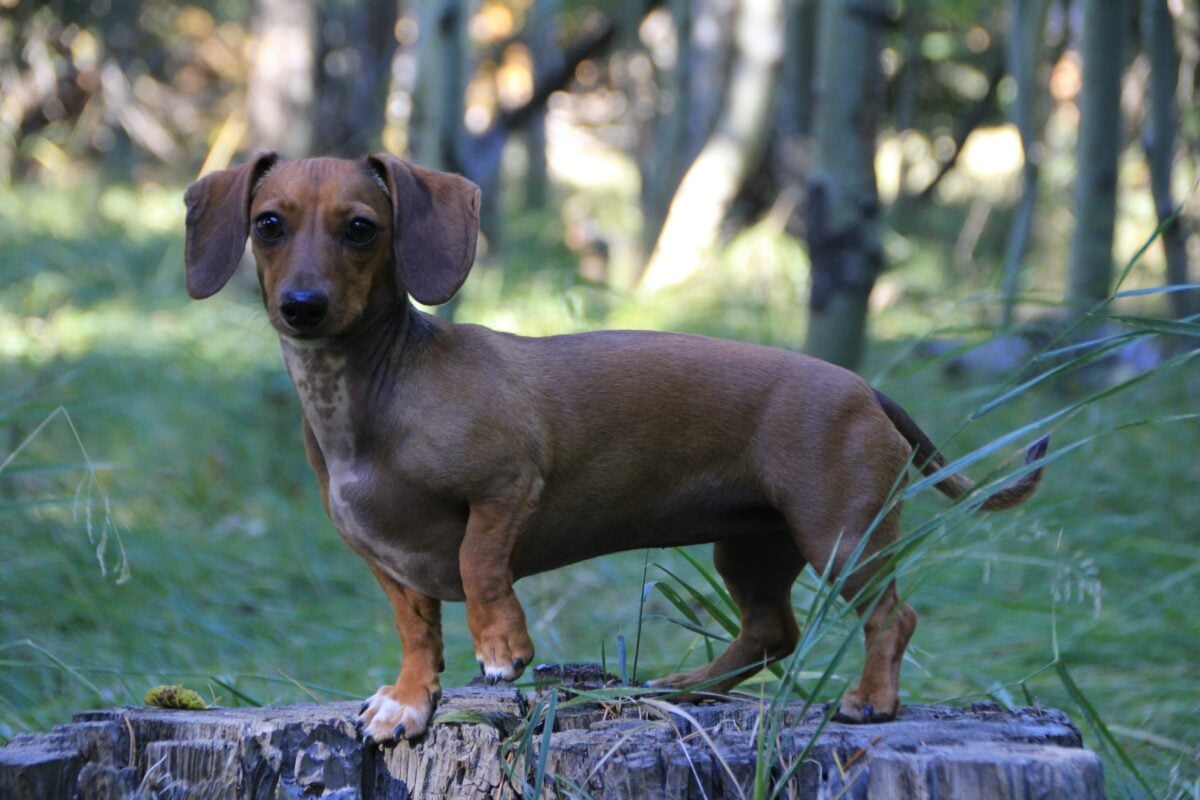
Key Traits
- Appearance: Long body, short legs, and smooth or wire-haired coat
- Temperament: Brave, alert, affectionate, and sometimes stubborn
- Other Traits: Moderate exercise needs, can be vocal, and may develop back issues if overworked or overweight
Want to dive deeper into each parent breed? Check out our full comparison: Dachshund vs Beagle.
The Mix: Doxle
The Doxle is a small to medium-sized hound that blends the best (and boldest) traits of the Beagle and the Dachshund.
You can expect a loyal and playful companion who thrives on adventure and affection. Each Doxle is a little different, but most share a cheerful personality, compact body, and boundless curiosity.
Because both parent breeds were developed as hunters, this mix loves to explore. Doxles thrive on daily walks, puzzle toys, and plenty of sniffing opportunities.
Some Doxles resemble miniature Beagles, while others take after the Dachshund with longer backs and shorter legs. Their coats can be smooth, wiry, or a combination of both, often featuring Beagle-style patterns or markings.
With the right training and structure, they make loving, loyal family pets who enjoy being the center of attention.
Watch: Meet Seager, a rescued Doxle who never skips playtime — or beach digging.
Temperament
The Doxle is an affectionate, high-energy companion who lives for attention and adventure. They form deep bonds with their families and often follow their favorite person from room to room.
They are alert, vocal, and eager to protect their home. A Doxle will ensure you’re aware of every delivery, squirrel, or passing neighbor.
This mix loves to play, explore, and join in on whatever you’re doing. They’re happiest when included in daily routines and get along well with kids and other pets when socialized from an early age.
Pro Tip: Doxles love to dig. Give them a sandbox or designated digging area to release that instinct, or your yard and furniture might take the hit.
With proper exercise and structure, they become loyal, joyful family dogs who bring endless personality to your household.
Watch: Meet Galileo, the four-year-old Doxle who takes “squirrel patrol” very seriously.
Size & Appearance
The Doxle is a small to medium-sized dog that usually weighs between 16 and 30 pounds. Most stand around 12 to 15 inches tall, depending on which parent they take after.
They often inherit the Dachshund’s short legs and long body, paired with the Beagle’s soft expression and floppy ears. Their snout can be short or medium-length, and most have warm brown eyes and black noses.

Color and coat type vary widely. Some Doxles have smooth, shiny fur, while others have a wiry or slightly coarse coat.
Fun Fact: No two Doxles look exactly alike. Their colors range from Beagle-style tri-color patterns to Dachshund shades, such as chocolate, cream, gold, or blue.
Because each pup inherits a different mix of traits, your Doxle may look more like one parent or land perfectly in between. That unpredictability is part of their charm.
Grooming
Doxles can have short, medium, or long coats, depending on which parent they take after. Coat length determines how often you need to brush them.
- Short coat: Brush once a week to remove loose hair and distribute oils.
- Medium coat: Brush two to three times a week to prevent tangles.
- Long coat: Brush daily to keep fur soft and mat-free.
Regular nail trims are a must. Overgrown nails can scratch furniture and cause discomfort when walking.

Care Tip: Start handling your Doxle’s paws early so nail trims become a routine, rather than a struggle. Offer treats and praise to build a positive association.
Dental care is just as important. While brushing your pup’s teeth twice a day is ideal, aiming for three times a week can help reduce plaque and keep their breath fresh.
Dental wipes, chews, and water additives can also help maintain oral health. Learn more about other ways to help keep your pup’s teeth clean.
Training & Exercise
The Doxle is intelligent, spirited, and eager to please when motivated correctly. They respond well to structure but may exhibit a stubborn streak, especially if they inherit this trait from their Dachshund parent.
Consistency and patience are key. Positive reinforcement, such as using treats, toys, or praise, works far better than scolding or punishment.
Obedience training and socialization training must start early. Teach your pup how to behave around other dogs, cats, and children to prevent future challenges.
Training Tip: Doxles love to follow their noses. Use scent-based games, such as “find the treat,” to make training sessions fun and mentally stimulating.
If you plan to harness-train your Doxle, begin as soon as possible. Their prey drive and long body shape make early leash manners especially important. Look for harnesses made for longer-backed breeds to prevent strain.
Daily activity keeps this mix healthy and happy. Aim for at least an hour of exercise split between morning and evening sessions.
Walks, backyard play, or short games of fetch all help burn off energy. Doxles love variety, so mix in agility, sniff walks, or puzzle toys for enrichment.
Despite their outdoor roots, they aren’t built for extreme weather. Bring them inside during cold or wet conditions and provide a cozy space for them to sleep.
Watch: Shiggy’s agility training helps strengthen her core and prevent back strain — a smart way to protect long-bodied breeds.
With consistency, affection, and regular exercise, the Doxle grows into a well-behaved, loyal, and entertaining family companion.
Health
The Beagle Dachshund mix is generally healthy, but no breed is entirely free of risk. Mixing two purebreds can reduce the odds of inherited conditions, though owners should still be mindful of weight and diet.
Dachshunds are prone to musculoskeletal issues, such as intervertebral disc disease (IVDD), due to their long backs. They can also develop obesity, which adds extra strain on their spine and joints.
Beagles often face thyroid, eye, and clotting disorders as they age. Common concerns include hypothyroidism, glaucoma, and factor VII deficiency.
Health Watch: Keep your Doxle at a healthy weight. Excess weight is the fastest path to back and joint problems in this breed.
Routine vet visits, portion control, and regular exercise go a long way toward preventing health issues. Watch for early signs of stiffness, limping, or eye irritation, particularly as your dog ages.
The Doxle’s average lifespan ranges from 11 to 14 years, though some live longer with proper care. A balanced diet, daily movement, and joint-friendly supplements can support longevity.
Watch: This Doxle is adorable, but it’s also good reminder that extra weight can sneak up fast on this mixed breed.
Pet insurance is worth considering for this mix. It won’t cover pre-existing conditions, but it can ease the cost of accidents, chronic illnesses, or emergencies. Learn more about your options in our Best Pet Insurance Guide.
Nutrition
The Doxle thrives on a balanced diet rich in protein and healthy fats with limited carbohydrates. Puppies require approximately 22% protein, while adults are well-suited to 18%, as per AAFCO guidelines.
Feed whole, quality meats like fish, beef, or chicken as the main protein source. Avoid fillers or low-grade byproducts that can lead to weight gain and reduced energy levels.
Smaller Doxles require nutrient-dense food specifically designed for smaller breeds, while mixes exceeding 30 pounds can transition to regular formulas. Select recipes specifically designed for active dogs to support their muscle tone and metabolism.
Feeding Tip: Since Doxles burn energy quickly, split their meals into two or three smaller portions per day. This helps keep blood sugar steady and prevents overeating.
Puppies benefit from multiple small meals throughout the day as they grow. Consistency in feeding times also helps with training, digestion, and predictable bathroom routines.
As Family Pets
Doxles are cheerful, clever, and full of character. They’re small enough for apartment living but happiest when they have room to explore.
These dogs crave attention and form strong bonds with their people. Expect a loyal shadow who wants to be part of every family activity.
They can be a little stubborn, so early training and plenty of patience pay off. In return, you’ll get a devoted companion with a fun, expressive personality.
Watch: Meet sibling Doxles Betty and Frank, who always perk up at their favorite words.
Key Things To Know
- Usually need about one hour of exercise per day
- Grooming ranges from low to high, depending on coat type
- Moderate shedders at most
- Great with children when socialized early
- Can be vocal watchdogs
- Should avoid stairs or rough play due to back sensitivity
Family Fit Tip: Choose a breeder who screens for back and joint issues, and ask to see health records for both parents.
Breeders & Puppy Prices
Because both Dachshunds and Beagles are popular family dogs, finding a Doxle breeder usually isn’t difficult. Expect to pay between $500 and $1,000, depending on pedigree and location.
Lower-priced puppies may come without health documentation, while higher-priced litters often include papers and health clearances. Always research breeders carefully and ask to meet the parents before making a commitment.
Buyer Tip: Avoid “too-good-to-be-true” listings or sellers unwilling to share medical records. Responsible breeders prioritize health over speed of sale.
A healthy Doxle puppy is worth the investment. Ethical breeders test for common conditions like IVDD, obesity, and thyroid disease to give puppies the best start.
Doxle Rescues
Adopting is another excellent way to bring a Doxle home. Contact local Beagle or Dachshund clubs for rescue referrals, or search shelters that specialize in hound mixes.
Because both breeds can be stubborn, they’re sometimes surrendered by owners who feel overwhelmed. This means you have a good chance of finding a Doxle waiting for a second chance.
Adoption fees are far lower than breeder prices, usually covering vaccinations and spay or neuter costs. The only drawback is that you may not know the dog’s complete history; however, rescued Doxles are often loving and loyal pets once they are settled into a stable home.
Adoption Highlight: Check breed-specific rescues for Doxles in need. You might find your perfect match while giving a pup a new start.
Are You Ready For A New Dog?
Adopting a new pup of any age is a big commitment. Be sure you weigh all the responsibilities and costs that come with adopting a new pet. Talk to other family members, especially children and teenagers, about the role they may play in caring for this new pet and being a responsible pet owner.
